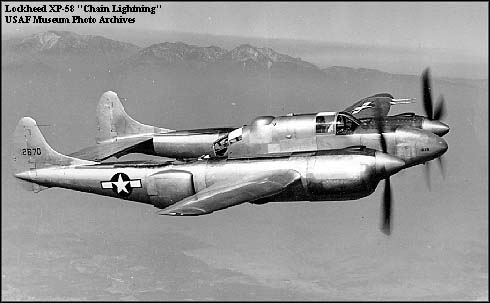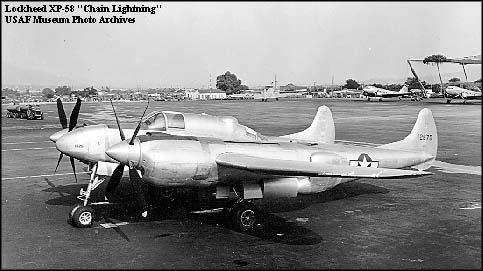U.S.A.A.F. RESOURCE CENTER > EXPERIMENTAL > PREVIOUS PAGE

In July 1940, Lockheed decided to switch to Pratt & Whitney XH-2600 engines as aircraft would be underpowered with the Continental engines, with the aircraft having two seats and designated "XP-58". However, soon Lockheed was advised the development of the XH-2600 engine was terminated. After consideration of the engine alternatives, the design was changed to use two Wright R-2160 Tornado engines, as well as a change of the rear-facing armament to two turrets, one upper and the other lower on the fuselage, each turret containing two .50 in machine guns. As support equipment for the two crewmen was added, the estimated weight of the XP-58 grew to 34,232 lb (15,527 kg) by August 1941.
In March 1942, the USAAF placed an order for a second XP-58 that would incorporate increased fuel tanks to obtain a range of 3,000 mi (4,800 km). The Air Force were uncertain about the role and armament of the aircraft, and in September 1942, a decision was made to convert the aircraft for a role as a low-altitude attack aircraft, armed with a 75 mm M5 autocannon. Adequate aircraft were already available for this mission, with the Douglas A-26 Invader and Beechcraft XA-38 Grizzly under development. As a result, the second XP-58 was canceled and the role of the design reverted to that of a high-altitude fighter, using large-bore cannon firing high-explosive shells to break up bomber formations.
The 37 mm M4 autocannon was originally selected for a quadruple mount in the nose, but the trajectory of the 37mm shells dropped lower than other weaponry, limiting its effective range. A hydraulically articulated nose that could be bent up to correct this problem was tried, but was dismissed as too complex. Then, a 75 mm M5 autocannon paired with twin .50 in machine guns was tried and proved much more successful.
|
Type: High-Altitude Bomber Destroyer Origin: Lockheed Crew: Two Model: XP-58 First Flight: June 6, 1944 Production: 1 Prototype POWERPLANT(S): Model: Allison V-3420-11/13 Type: 24-Cylinder Vee liquid cooled engine Number: Two Horsepower: 3,000 hp DIMENSIONS: Wing span: 70 ft. 0 in. Length: 49 ft. 4 in. Height: 16 ft. 0 in. Wing Surface Area: 600 sq. ft. (55.74 m²) WEIGHTS: Empty: 31,624 lb. (14,344 kg.) Maximum: 39,192 lb. (17,777 kg.) |
PERFORMANCE: Maximum Speed: 436 mph at 25,000 ft. Maximum Cruising Speed: 274 mph at 25,000 ft. Initial Climb Rate: 2,660 ft./min. Service Ceiling: 38,400 ft. ARMAMENT: 4 x 37mm cannon Ammunition: 250 rounds per gun
4 x .50 M.G. in remote controlled turrets
1 x 75mm cannon
2 x .50 M.G. in nose
4 x .50 M.G. in remote controlled turrets |
Green, William - War Planes Of The Second World War - Fighters - Vol. 4, 1964, Doubleday And Company, Inc., New York
U.S.A.A.F. RESOURCE CENTER > EXPERIMENTAL > PREVIOUS PAGE






